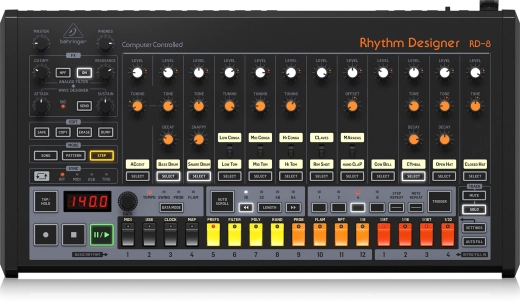Behringer RD-8 MKII Classic Analog Drum Machine
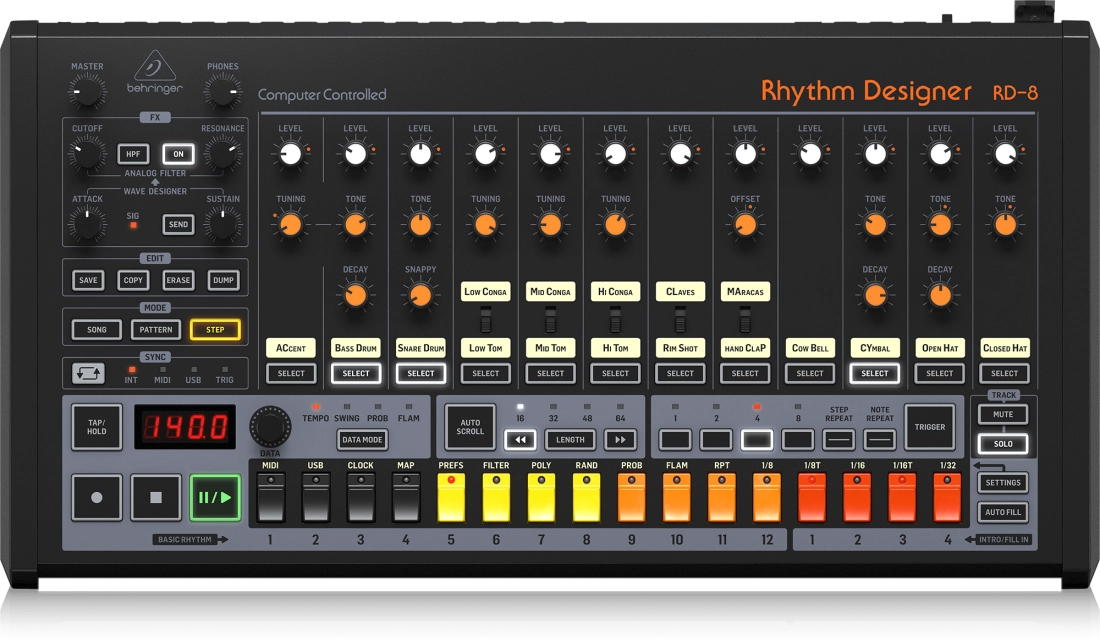
Additional Photos:
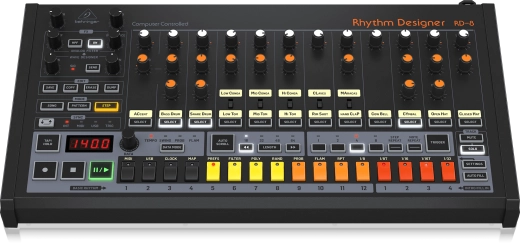
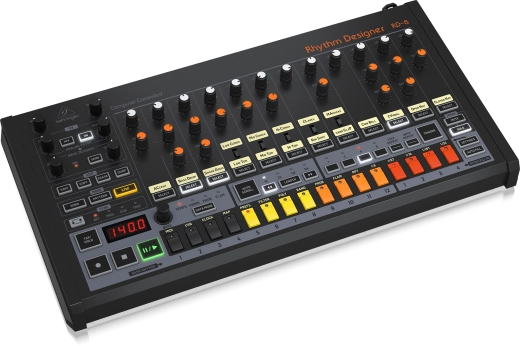
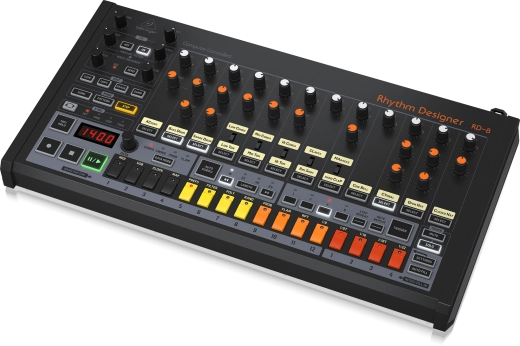

Masterpiece Rejuvenated
Great care has been taken in designing the RD-8 MKII to achieve new possibilities in beat creation by reviving a timeless analog design from one of the most classic drum machines of yesteryear. By taking a fresh and modern approach on a classic drum machine, the RD-8 MKII gives you the power to harness the phenomenal sound of the 808 and tap into some new features as well. Now with a faithful reproduction of the legendary 662 OTA chip, you will have in your hands the most authentic sounds that you can create in a modern drum machine. Colossal bass drums through to sizzling hi-hats can be manipulated to elevate your rhythm performance to the next level. This is an analog beat-making monster!
Live Performance Beat Master
Built to enhance the way you perform, the RD-8 MKII boasts all-new features for live use in each of the sequencer modes including step repeat, note repeat, real-time triggering and live step-overdubbing. This makes it easy to enable recording in pattern launch mode so you can build song structures on the fly and switch back to manual mode at the touch of a button. Then you are free to add some excitement with the autofill feature and to introduce more variations. You can even cue up another song from memory without interrupting playback, allowing you to perform entire sets from start to finish just using your RD-8 MKII!
Powerful and Feature-Rich Sequencer
The RD-8 MKII features one of the most powerful step sequencers ever created, which provides much improved workflows over the original. The 64-step sequencer also includes storage for up to 256 patterns and 16 songs, allowing the creation of song arrangements ranging from ultra-simple to incredibly complex.
Wave Designer and Dual-Mode Filter
The integrated Wave Designer has individual attack and sustain controls that can be applied to individual voices to bring another dimension to your drum beats. This provides yet another way to control sounds to build virtually unlimited and awesome new tones. Additionally, the RD-8 MKII's highly flexible dual-mode 12 dB filter button toggles between LPF and HPF, allowing you to experiment with the cutoff frequency and resonance controls to create out of this world beats. Those fluid sweeps can even be recorded straight into the sequencer and further tweaked using the step editor.
Parameter Chaining
The RD-8 MKII's robust encoder lets you set separate chain preferences for each of your parameters, allowing them to function globally or to switch on when a song or pattern changes. Parameters include tempo, swing, flam, probability, independent track mutes/solos, FX bus assignments, filter modes and sweeps for enhanced real-time control. Patterns can be changed on the fly for further creative control when using the RD-8 MKII as the heart of your live setup.
USB Control
To bring the RD-8 MKII into the modern age, USB connectivity has been added for sync and MIDI triggering. This enables the RD-8 to be controlled by your DAW if desired, allowing songs and patterns to be swapped or individual sounds to be triggered.
The Numbers
The RD-8 MKII has 29 knobs, 5 switches and 59 buttons, all laid out in a highly intuitive format that puts the fun back into your beat creation. Input and output connections include: Phones; Mono audio; MIDI In, Out and Thru over USB and 5 pin MIDI ports; and 11 independent analog outputs for external processing or recording your rhythms as multitrack audio. With its 3 trigger outs, the RD-8 lets you control external synths and hardware sequencers to create songs without a digital audio workstation (DAW) in sight. The RD-8 can also send and receive clock information with highly accurate timing to sync it to the outside world.
Features
• Amazing drum machine with authentic analog sound engine to create classic sound performance• 16 original drum sounds with additional parameters and global accent capability
• Reproduction of legendary 662 OTA chip for ultimate sound authenticity
• Powerful 64-step drum sequencer supports poly-meter, step-repeat, note-repeat, real-time triggering, track-mute and track-solo
• 11 independent analog outputs for external processing or recording your rhythms as multi-track audio
• Integrated FX bus features Wave Designer and dual-mode Analog Filter with per voice assignment
• Live recording, editing and playback of analog filter cutoff via automation
• Storage of up to 16 songs and 256 patterns, all of which can be imported/exported during playback for unlimited songs and patterns
• Pattern Mode allows arrangement of patterns into full songs and setting number of repeats per song part
• Song Mode allows chaining songs together for live sets and expanded compositions
• Unique Auto Scroll feature enables improvisation in all modes
• Comprehensive MIDI In/Out/Thru plus USB implementation for synchronization and connection to external devices
• Sync options include USB, MIDI, Clock and Internal for maximum versatility
• Encoder for editing parameters such as Tempo, Swing, Probability, Flam and Random
• High-visibility LED display for easy editing of program parameters
• Powerful headphone and main outputs
Specification
Voices- Number of sounds: 16
- Type: Analog
- Number of simultaneous voices: 11 (12 including global accent)
- Accent: Level
- Bass drum: Level, tone, decay, tuning
- Snare drum: Level, tone, snappy
- Low, mid, hi conga / low, mid, hi tom: Level, tuning, voice selection
- Claves / rim shot: Level, voice selection
- Maracas / hand clap: Level, offset, voice selection
- Cow bell: Level
- Cymbal: Level, tone, decay
- Open hat: Level, tone, decay
- Closed hat: Level, tone
- Select buttons: 16 Voice select buttons
Connectivity
- Phones: 1 x 1/4" TRS, stereo, 8 Ω impedance
- Mono: 1 x 1/4" TRS, servo-balanced
- Voice out: 11 x 1/4" TS, unbalanced
- MIDI In, Out & Thru: 3 x 5-pin DIN
- Trigger outs: 3 x +5 V, 1 ms pulse
- Clock in / out: 2 x 1/8" TS
- USB: Class compliant USB 2.0, type B
- Supported operating systems: Windows 7 or higher Mac OS X 10.6.8 or higher
- Volume controls: Master, phones
- Return (Input): 1 x 1/4" TRS, balanced
Wave Designer
- Bus: 11 voices, independently assignable
- Attack: -15 to +15 dB, adjustable
- Sustain: -24 to +24 dB, adjustable
- Send button: On/off, switchable
- Sig LED: Red
Analog Filter
- Type: State variable, 12 dB slope
- Cutoff: 10 Hz - 15 kHz, adjustable
- Resonance: 0 - 10, adjustable
- HPF button: LPF / HPF mode, switchable
- On button: On / off, switchable
Sync Section
- Mode selector: Internal / MIDI / USB / Clock, selectable
Sequencer Section
- Edit buttons: Save, copy, erase and dump
- Mode buttons: Song, pattern and step
- Control: Encoder for data editing
- Playback controls: Tap / hold, record, stop, play / pause
- Data mode: Tempo / swing / prob / flam, selectable
- Auto scroll: On / off, rewind, length (16 / 32 / 48 / 64, selectable), fast forward
- Trigger: On / off, repeat division (1 / 2 / 4 / 8, selectable), step repeat, note repeat
- Track: Mute / solo, selectable
- Step buttons: 16 step enter buttons
Settings
- Settings: Enter settings mode, use step buttons to select operation.
Autofill
- Autofill: Enter autofill selection mode
Songs / Storage
- Song mode: Chain any of the 16 songs together for full sets
Pattern / Storage
- Capacity: 16 songs, 16 patterns each
- Pattern mode: Up to 99 iterations per pattern/part
- Steps: 64 steps
Power Supply
- External power adapter: 18 V DC, 1000 mA
- Power consumption: 15 W typical
Environmental
- Operating temperature range: 5°C to 40°C (41°F to 104°F)
Physical
- Dimensions (H x W x D): 77 x 498 x 265 mm (3.0 x 19.6 x 10.4")
- Weight: 3.0 kg (6.6 lbs)
Q & A
Reviews

Protect your investment with the Long & McQuade Performance Warranty
A warranty can be a very important factor when making a buying decision. Because repairs can be very expensive in terms of parts and labour costs, manufacturers usually only provide one year limited warranties that generally only cover items that malfunction due to a manufacturer’s defect. With an important purchase such as a musical
instrument or piece of studio gear, however, many people want to have the peace of mind in knowing that their investment will be protected should the product no longer be performing at 100%.
Because of this, Long & McQuade provides our customers with a FREE one-year Performance Warranty on most of our products. The Long & McQuade Performance Warranty supplements the manufacturer’s warranty to ensure that our customers receive complete “no hassle” warranty coverage within their first year.
How does the Long & McQuade Performance Warranty differ from most manufacturers' warranties?
- Performance Guarantee: Normal wear and tear is covered, so your product will be performing as well as the day you purchased it for the entire duration of the coverage. Band and Orchestral Performance Warranty does not include replacing pads or cleaning for woodwind instruments, unless deemed necessary by our repair staff. Ultrasonic cleaning for brass instruments will be provided if deemed necessary by our repair staff, but is not routinely offered under the Performance Warranty.
- Product Replacement: If your product cannot be fixed or costs too much to fix, we will replace it with the equivalent model for no additional charge. If this is not possible, a full refund will be provided.
- No Lemon Policy: Your product will be replaced should the same problem occur multiple times.
- Convenient: Easy drop off and pick up of the product at any Long & McQuade location.
- Guitar Setup: Guitars purchased at Long & McQuade come with 1 free setup, to be redeemed within 1 year for new guitars and 90 days for used guitars.
- Loaners Available: A loaner product may be given while the product is being repaired.
- Power Surge Protection: Your product is covered even if damaged from a power surge.
- Accessory Coverage: Any peripheral devices or accessories that come with your product (i.e. foot pedal, case) are also covered.
- Commercial Use Coverage: Music and recording professionals who purchase gear for “heavy-use” commercial purposes will still be covered.
Long & McQuade reserves the right to restrict the purchase of additional years of Performance Warranty. Used products come with a 3-month Long & McQuade Performance Warranty. Some products (i.e. computers, software, cymbals and other items) are covered only by the manufacturer‘s warranty. Consumables (i.e. strings, reeds, drum sticks, batteries, tubes, cross faders) are excluded as they are designed to be replaced. Cosmetic Damage, Accidental Damage, or problems caused by Humidity or Temperature Issues are not covered. Speakers damaged by overpowering are generally not covered. Our coverage does not provide compensation for loss of use. As of June 2018 the Performance Warranty is no longer transferable. The warranty is only valid in Canada.
Purchasing additional years of coverage
Some manufacturers provide warranties for longer than 1 year; however, these are usually limited warranties that do not provide the same coverage as the Long & McQuade Performance Warranty. Customers interested in more complete and convenient (but not necessarily longer) coverage are still able to purchase additional years of the Performance Warranty.
If you are interested in receiving this coverage for longer than one year, you have the option of purchasing additional years of the Performance Warranty. The pricing is as follows:
- NEW products: Starting at 4% of the current new selling price to double the warranty from 1 year to 2 years. Starting at 4% for each additional year.
- USED products: Starting at 4% of the current new selling price to increase the warranty from 3 months to 1 year. Starting at 4% for each additional year.
- GUITARS: 4% of the current new selling price to double the warranty from 1 year to 2 years. 4% for each additional year. $45 maximum. An additional free setup is not included with additional purchased years of Performance Warranty.
- BAND and ORCHESTRAL instruments: 4% of the current new selling price to double the warranty from 1 year to 2 years. 4% for each additional year.




